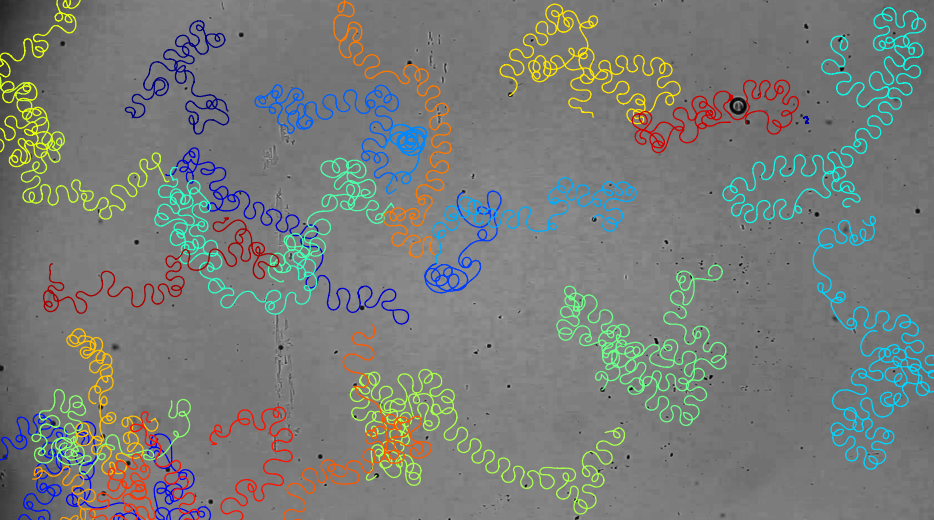DFG Priority Programme "Microswimmers"
Priority Programme “Microswimmers – From Single Particle Motion to Collective Behaviour” (SPP 1726)
Research Activities
SPP Funded Projects

Artificial microswimmers formed by liquid crystal droplets
Christian Bahr, Corinna C. Maaß
Max Planck Institute for Dynamics and Self-Organization, Göttingen
Swimming of active colloids in artificial potentials
Larysa Baraban, Arthur Philip Nikolaus Erbe
TU Dresden; Helmholtz-Zentrum Dresden-Rossendorf

Active particles in viscoelastic fluids
Clemens Bechinger
University of Stuttgart

Chemical nanomotors
Michael Börsch, Peer Fischer
Uniklinikum Jena; Max Planck Institute for Intelligent Systems, Stuttgart

Propulsion and interaction of hot Brownian swimmers
Frank Cichos, Klaus Kroy
Leipzig University

Flagelated and ciliated microswimmers
Jens Elgeti, Gerhard Gompper
Forschungszentrum Jülich

Magneto-aerotaxis in magnetotactic bacteria
Damien Faivre, Stefan Klumpp
Max Planck Institute of Colloids and Interfaces, Potsdam-Golm

From solitary swimmers to swarms and back: trypanosomes on their journey through the tsetse fly
Markus Engstler
University of Würzburg

Collective non-linear dynamics of cilia and flagella: from n=2 to n>>2 interacting cilia
Benjamin M. Friedrich
Max Planck Institute for the Physics of Complex Systems, Dresden

Magnetocapillary microrobots: hunting, harvesting and transporting objects at fluid interfaces
Jens Harting
Helmholtz Institut Erlangen-Nürnberg

Cooperative behavior of microswimmers: the effect of ionic and reactive screening on hydrodynamic interactions in complex fluids
Christian Holm
University of Stuttgart
Analysis of the regulation of the flagella beating pattern using optogenetics
Jan Fritz Jikeli, Dagmar Wachten
Universitätsklinikum Bonn

Biological microswimmers: from cellular signal processing to the 3D beating pattern and 3D swimming behaviour
U. Benjamin Kaupp
Forschungszentrum caesar, Bonn

Deformable microcapsules and droplets as swimmers
Jan Kierfeld
Technical University of Dortmund

Microscopic statistical theoretical description of the collective behaviour of microswimmers
Hartmut Löwen, Andreas Menzel
Heinrich Heine University Düsseldorf
Selforganization of active flow in a nematic swimmer
Marco Mazza
Max Planck Institute for self-organization

Light driven microscopic hydrogel objects
Martin Möller
DWI Leibniz Institute for Interactive Materials

Modular phoretic micro-swimmers: from individual drifters to multi-component self-propelling complexes and interacting swarms
Thomas Palberg
Johannes Gutenberg University of Mainz

Cooperative properties of thermophoretic microswimmers
Marisol Ripoll
Forschungszentrum Jülich

Light induced diffusioosmose: from the manipulation via self-propulsion to collective behaviour of microcolloids at solid-liquid interfaces
Svetlana Santer, Olga Vinogradova
University of Potsdam, Moscow state university

Swimming behaviour of a sperm-flagella driven micro-bio-robot – from Fundamental Studies to Biomedical Applications
Oliver G. Schmidt
Leibniz-Institute for Solid-State and Materials Research Dresden e.V.

Dynamical aggregation of self-propelled colloidal particles
Thomas Speck, Peter Virnau
Johannes Gutenberg University of Mainz

How hydrodynamics influences the collective motion of microswimmers: a particle based simulation study
Holger Stark
Technical University of Berlin

Modecoupling theory of active Brownian particles
Thomas Voigtmann
German Aerospace Center, DLR, Cologne

Bacterial Swarming: Role of Flagella in Emergent Behavior
Roland G. Winkler
Forschungszentrum Jülich
Associated Projects

Active particles near interfaces and in external fields
Siegfried Dietrich, Mihail Popescu, William E. Uspal
Max Planck Institute for intelligent systems, Stuttgart

Bacterial turbulence in the environment
Knut Drescher
Max Planck Institute for Terrestrial Microbiology; Philipps-Universität Marburg

Investigation of the self-propulsion of Janus particles near a polymer functionalized surface
Regine von Klitzing
Technical University of Berlin
Novel composite materials for development of light driven active matter
Juliane Simmchen
TU Dresden

Deciphering how motile cilia regulate and coordinate their beating in order to produce a biologically-relevant flow
Nathalie Jurisch-Yaksi
Kavli Institute for Neuroscience
